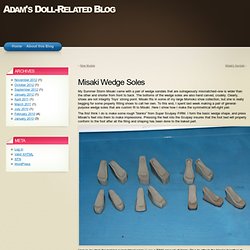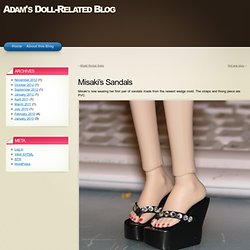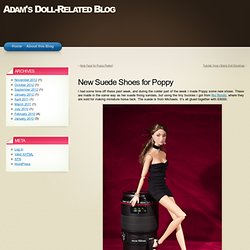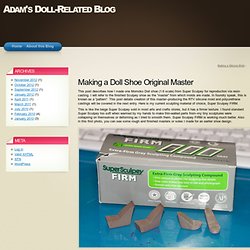

How to Make Your Own Barbie Shoes. How To Make Barbie Boots From Clay. Using Polymer Clay to Make Doll Shoes. How To Create Clay Doll Shoes. How to Make Doll High Heel Shoes. How To Carve A Doll Shoe From Polymer Clay. How To Make A Femo Clay High Heeled Shoe. Misaki Wedge Soles « Adam's Doll-Related Blog. My Summer Storm Misaki came with a pair of wedge sandals that are outrageously mismatched–one is wider than the other and shorter from front to back.

The bottoms of the wedge soles are also hand carved, crudely. Clearly, shoes are not Integrity Toys’ strong point. Misaki fits in some of my large Momoko shoe collection, but she is really begging for some properly fitting shoes to call her own. To this end, I spent last week making a pair of general-purpose wedge soles that are custom fit to Misaki. Misaki’s Sandals « Adam's Doll-Related Blog. Misaki’s now wearing her first pair of sandals made from the newest wedge mold.

The straps and thong piece are PVC. This entry was posted on February 5, 2010, 4:37 am and is filed under Doll Shoes. You can follow any responses to this entry through RSS 2.0. Both comments and pings are currently closed. New Shoes For Poppy Parker « Adam's Doll-Related Blog. Over the past two weekends, I worked on making some new shoes for Poppy Parker.

She can wear quite a few Momoko shoes, and all the shoes I made for Misakis, but I have enough Poppies now to justify making some that are custom fit for her foot, which is similar to Misaki’s, but smaller. Below, Poppy is wearing the latest pair I made just for her, the final construction steps of which are the subject of this blog entry. The shoe is built around a custom-molded polyurethane wedge sole, the creation process for which is documented in an earlier entry: Misaki Wedge Soles.
This blog entry will focus on the steps that happen after the plastic casting, to create the finished product: This first photo shows how I secure the thong portion of most of my thong style sandals. New Suede Shoes for Poppy « Adam's Doll-Related Blog. I had some time off these past week, and during the colder part of the week I made Poppy some new shoes.

These are made in the same way as her suede thong sandals, but using the tiny buckles I got from Rio Rondo, where they are sold for making miniature horse tack. The suede is from Michaels. It’s all glued together with E6000. I threaded the ankle strap through backwards, but didn’t realize this until I was editing the photos, this is why the buckle is facing inwards in this shot. This entry was posted on January 6, 2012, 8:51 pm and is filed under Doll Shoes. Making A Doll Shoe Original Master « Adam's Doll-Related Blog. This post describes how I made one Momoko Doll shoe (1:6 scale) from Super Sculpey for reproduction via resin casting.

I will refer to the finished Sculpey shoe as the “master” from which molds are made. In foundry speak, this is known as a “pattern”. This post details creation of this master–producing the RTV silicone mold and polyurethane castings will be covered in the next entry. Here is my current sculpting material of choice, Super Sculpey FIRM. This is like the beige Super Sculpey sold in most arts and crafts stores, but it has a firmer texture. Here (below) is how I start out. After massaging the Sculpey into a suitable wedge, I rolled some to about 3/32″ thickness and cut out a strip to form the back of the shoe. I use the same thickness for the toe piece: Next, I smoothed the pieces together with my fingers and ball-end Sculpey Studio tools, and trimmed away excess to form clean lines.
Here you can see the stat of the piece just prior to baking for 20 minutes at 175°F. Making A Silicone Mold « Adam's Doll-Related Blog. Brace yourself for an über-lengthy, image-dense blog post full of Smooth-On products I purchased from their Boston distributor, Reynolds Advanced Materials.
In my last entry, I showed how I made a master model of a Momoko shoe from Super Sculpey. In this post, I will show the steps I use to make RTV silicone molds for casting the final product in polyurethane. This particular shoe project actually had two mold-making steps because my master Sculpey shoe was not left/right-specific. I first made a mold to reproduce the Sculpey shoe in urethane, then I carved two of the first-generation urethane castings to be a left and right pair.
This pair then became the left and right masters for the final pair mold. How to Make Professional Doll Shoes.